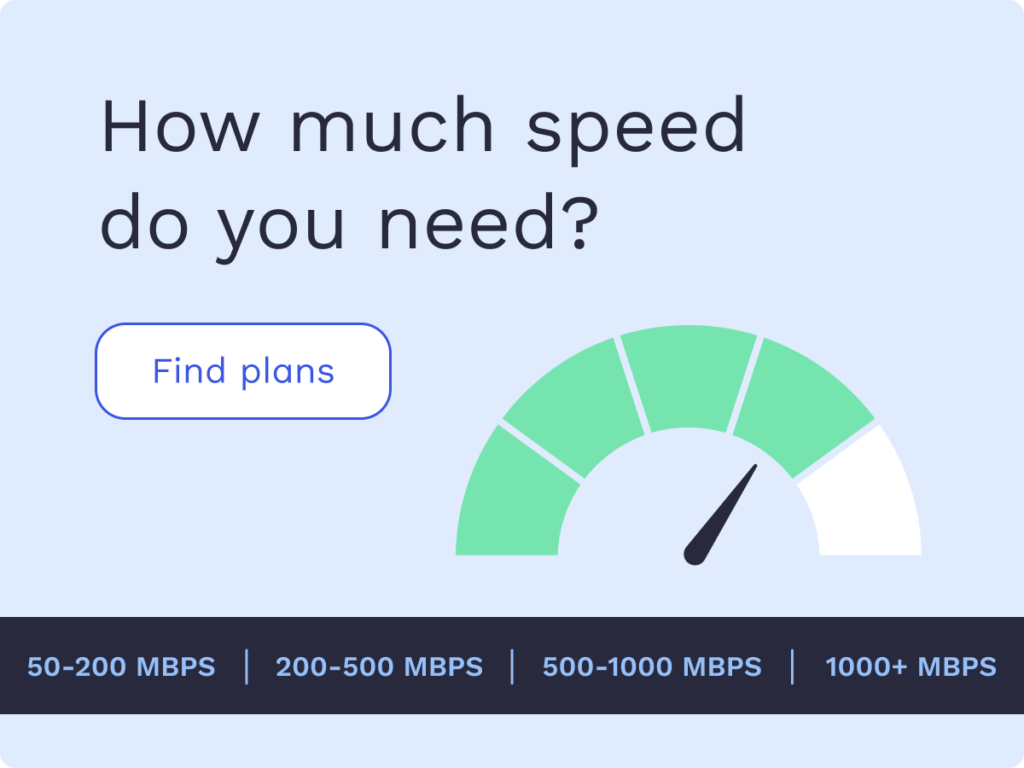Which Internet Service is Best for Working from Home?

Curious what internet and TV plans are available locally?
Enter your address to find out what providers and plans are available to you.
Whether you’re working remotely one day a week, every day, have a condensed workweek or telecommute from time to time, you need internet service that is reliable and can handle the bandwidth demands. And there are plenty of internet service providers (ISPs) to help you connect—no matter where you are. But which internet service is the best for working from home?
- The big players
- Key considerations
- What others are saying
- Best internet for working from home FAQs
- Choosing your provider
The big players
Based on current availability and the criteria outlined below, the four leading ISPs for remote work include: Verizon, Xfinity, Google Fiber and AT&T.
There are other ISPs out there, but these four providers earn top marks for folks working from home because they:
- Are available in many cities across the country, so even if you’re moving, at least one should be an option
- Offer the best internet for working from home with speeds of at least 200Mbps
- Offer base packages that cost $70/month or less, so you don’t have to spend too much of your hard-earned cash
- Have plenty of positive customer reviews
- Provide the option for unlimited data
Beyond the question of availability (and we can help with that, too), we offer some additional answers to help you decided which is best for your needs.
Key considerations
If you’re working from home, your needs may be slightly different than someone who just uses the internet for streaming content, gaming, or browsing. When assessing ISPs, you should keep in these things mind:
Speed
AT&T gives you the most speed with a blazing fast 5000Mbps. Xfinity offers speeds up to 1200Mbps and Google Fiber comes in third with a plan offering 1000Mbps. Verizon slides into the fourth spot among these ISPs with speeds up to 940Mbps.
Price
The best entry-level price goes to Xfinity, which costs $19.99/month for 50Mbps with a 1-year agreement in the Western US. Verizon is another lower-cost provider, offering a base package at $39.99/month, and AT&T is right behind at $55/month. You don’t have to agree to an annual contract for either AT&T or Verizon. Google Fiber’s blazing speed costs $70 if you pay month-to-month, but you can shave off $7 and pay $63/month if you sign up for a year.
Contracts
Neither AT&T nor Verizon requires a contract, but Xfinity does for most internet plans with the exception being their lowest tier plans for customers in the Northeastern US. You can also save on monthly fees by opting for a one-year agreement with Google Fiber.
What’s more, none of these providers have data limits, so you can have as many videoconferences as you want and download all the work files you need. But some factors may put one service above the other.
Are there extra fees?
Behind each price tag, some fees may make you lean towards one provider over the other. Some of the extra fees break down like this:
- Google Fiber charges users $750 upfront for their yearly plan that costs $63/month
- If you don’t order Verizon service online, you have to pay a $99 setup charge
- Xfinity, AT&T, and Google Fiber all charge setup fees that can vary based on location*
Do these plans have any speed limitations?
The speeds each carrier advertises are what you can get if you connect using an Ethernet cable. If you hook up via a Wi-Fi signal, your speeds may be a little less than what’s advertised.
Also, during peak times, when many people in your area are streaming, your speeds might not be as high as advertised due to network congestion. But with these ISPs, you should still have enough bandwidth to work from home, regardless of dips in speed during peak hours.
What others are saying
Want to know what people have to say about each of the service providers on our list? We’ve combed through unbiased reviews that emphasize factors that impact your ability to work from home, such as reliability, price, accessibility, and speed.
For example, Verizon holds the top spot of the American Customer Satisfaction Index (ASCI), tying with A&T for first place. It has also held JD Power’s top customer satisfaction score in the East for almost a decade. Xfinity came in third place in the ACSI rankings, with a score of 66 out of 100.
Google Fiber receives a 4.0 out of 5 rating from ConsumerAffairs.com, which gives it a slightly higher position on that site than Verizon (3.9 out of 5), Xfinity (3.8 out of 5), and AT&T (3.8 out of 5).
Best internet for working from home FAQs
How much bandwidth do you need to work from home?
Most people need at least 25Mbps to work from home. You can enjoy 720p HD video conferencing on Zoom using only 2.6Mbps of uploading bandwidth and 1.8Mbps of downloading bandwidth.
The higher speeds these ISPs provide really come in handy when downloading or uploading large files. If a coworker sends you a video recording they’d like to get your feedback on, you may have to wait several minutes for it to download if your speeds are significantly lower than what these ISPs offer. That’s why it’s best to aim for 200Mbps or higher if you want to work from home.
How much bandwidth do you need for VoIP calls and videoconferences?
According to popular VoIP and videoconferencing providers 8×8 and Zoom, you need between 5 and 25Mbps for VoIP calls and 2.6Mbps up and 1.8Mbps down for videoconferencing.
How can I make sure I get as much bandwidth as possible?
To maximize the bandwidth you get with your plan, your best bet is to use a wired connection whenever you can. In this way, you cut out the “middleman” of your wireless router, which can impede your signal due to built-in speed limitations.
My company has a virtual private network (VPN). How much bandwidth do I need to connect to that?
While it’s best to talk with your company’s network administrator about this, generally speaking, you only need enough bandwidth to download, stream, and conference as you would if there was no VPN in place. The amount of data transferred through the VPN won’t increase or decrease because you’re using a virtual private network.
Choosing your provider
For working from home, your choice for ISP comes down to speed and reliability, which is why Xfinity, AT&T, Verizon, and Google Fiber are among your best options.
Disclosure | Updater articles are based on our own data and research, independent from partner relationships. We are not compensated by partners for information and opinions presented here. Our Editorial Terms of Service can be found here.
Curious what internet and TV plans are available locally?
Enter your address to find out what providers and plans are available to you.
Internet and TV tips
Switching providers and don’t know where to start? We can help.














